GM crops, developing countries and food security
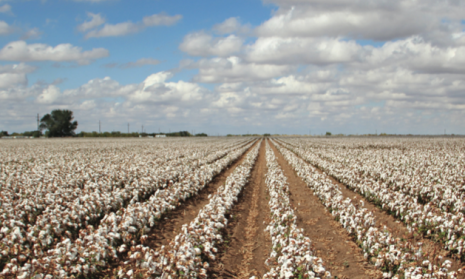
Summary
The agronomic and economic performance of genetically modified (GM) crops relative to their conventional counterparts has been largely investigated worldwide. As a result there is considerable information to conduct a meta-analysis to evaluate the agronomic and economic relative performance of GM crops vs. non GM crops by crop, GM trait, and country’s level of development. Such meta-analysis has been recently conducted showing that overall GM crops outperform non GM crops in both agronomic and economic terms (1). This paper focuses on the agronomic and economic performance of GM crops in developing and developed countries as well as the potential implications for global food security of adoption of GM crops by developing countries. The presumption that technology only benefits the developed world is not supported by the meta-analysis conducted. No evidence that GM technology benefits more- developed than developing countries was found. Indeed, the agronomic and economic performance of GM crops vs. conventional crops tends to be better for developing than for developed countries. Although it is manifested that the conventional agronomic practices in developing countries are different to those in developed countries, it is also apparent that GM crop adoption in developing countries may help to tackle the growing concerns over the scarcity of food globally.
Key words: Developing countries, Food security, meta-analysis, genetically modified crops, Abbreviations: PDF, Probability density function.
Introduction
Discussions on the potential agronomic, economic and environmental consequences associated with adoption of genetically modified crops are becoming increasingly relevant under current food security concerns (i.e. continuing population and consumption growth means increase in the global demand for food) (2).
Since the adoption of GM crops started in 1996 the adoption of these crops has grown rapidly. Currently, a total of 148 million ha are covered by GM crops worldwide; herbicide tolerant (HT) and insect resistant (Bt) being the two main commercialised traits (3). There has been a lot of discussion about the comparative performance of GM and conventional crops. A recent paper (1) used the scientific information available up to date to shed some light on this issue. Overall, the authors concluded that the agronomic and economic performance of GM crops outweighs the performance of their conventional counterparts. In particular, Bt (1) crops performed both agronomically and economically (gross margin) significantly better than their conventional counterparts. The picture for HT (2) crops is less clear with results suggesting marginal benefits from GM crops. GM crops economically outperformed non GM crops in both developing (3) and developed countries discrediting any presumption on new technologies only benefiting the developed world.
Data and Methodology
The authors conducted a meta-analysis to investigate the agronomic and eco- nomic performance of commercialised GM crops compared with their coun- terparts worldwide using a significant amount of information available through a total of 63 scientific publications. A weighted approach was used in order to give more weight to infor- mation (i.e. absolute differences in yield, production costs and gross mar- gins between GM and conventional crops) obtained from studies with large samples. Inferences about the agronomic and economic perform- ance of GM crops in comparison with conventional crops were made using Bayesian methods.
Specifically, means of the absolute differences in yield, production costs and gross margin were obtained. A major difference between the classical and the Bayesian approach is that the latter treats parameters as random variables. This means that the Bayesian approach yields distributional information for the parameter studied. Also, Bayesian analysis can incorporate prior information about the parameter analysed (in this case the absolute dif- ference of the variable of interest: yield, production cost, or gross mar- gin) using an appropriately chosen pdf.
In this case, a relatively diffuse prior was used reflecting no prior information on what the absolute difference of yield, production cost or gross margin between GM crops and their conven- tional counterparts may be. This effectively produces similar results to that using a classical approach (1).
Would GM technology adoption benefit the developing world?
The scope of the meta-analysis con- ducted by (1) covers different levels such as crop level, level of country’s development, world region and as a whole. One important question in the GM crop debate is whether GM crops perform well in developing countries, and whether, as a result, this may help delivering global food security challenges.
With a continuously growing popu- lation, the pressure on the global food system entails significant challenges regarding the stability of food supplies and prices while maintaining the biodiversity and ecosystem services and contributing to the mitigation of climate change (3).
Evidence suggests that adoption of GM crops may play a role in helping to achieve the stability of food supplies.
New technologies are usually devel- oped and taken first by developed countries and made available later for developing countries.
This has not been different for GM crops. However, although the GM crops area in developing countries was much smaller than in developed coun- tries, the rapid adoption of GM tech- nology by developing countries, especially since 2003, has meant that the GM crops area in developing countries has matched the GM crops area of developed countries in 2011, approxi- mately 80 million hectares (4).
Table 1 shows the mean and stan- dard deviation of conditional posterior distributions of absolute difference of the yield, production costs and gross margins between GM and conventional for developed and developing coun- tries (1). The table also shows the probability of each absolute difference to be above zero (i.e. the probability that GM, Bt and HT crops outperforms their conventional crops).
Figure 1 shows the posterior density function of the absolute differences between GM and conventional crops for yield, production costs and gross margins per countries’ development level and GM trait.
The posterior density function was estimated using kernel density estimation (i.e. using a kernel smoothing function). The values in the y axes are values for this function. A kernel is a more sophisticated version of a his- togram.
Therefore values in the y axes repre- sent a function of the frequency for values of the x-axis. While the x-axis represents the absolute differences between GM and non-GM crops for the variables of interest (i.e. yields, production costs and gross margins) the y-axis measures the frequency of these differences.
For instance, the top left graph (GM vs conventional yield) shows that on average most of the results for devel- oping countries fall between 0.3 and 0.4 tonnes/ha difference between GM and conventional (i.e. GM crops have higher yields than conventional).
Although most of the scientific papers focus their analysis in Bt cotton, (1) conducted the analysis per crop and showed that the average dif- ference in yield between Bt maize and conventional was 0.5 tonnes/ha for both developing and developed countries. Hence the adoption of GM crops by developing countries would con- tribute to the improvement of food security throughout a yield increase effect.
GM crops outperformed non-GM crops in both developing and developed countries in both agronomic and economic (gross margin) terms despite the relatively high price for GM seeds.
GM crops perform agronomically better than conventional crops in both developing and developed countries, with no significant differences in yields between them.
With regard to production costs adopting GM crops would have two effects: a reduction in costs due to savings in pesticides and an increase in costs due to higher GM seed prices.
The overall picture for production costs suggests that the GM seed prices tend to be higher than the savings in pesticides, particularly in developing countries, from where more informa- tion is available.
The better economic performance of GM crops is mainly attributed to the performance of Bt crops where most of the research has focused up to date. So far the evidence collated about the performance of HT crops is small and no conclusions should be taken from it.
The relatively large difference in gross margins in developing countries with respect to developed countries (see Figure 1) is possibly due to impor- tant differences in the quality of the crop between GM and their non GM counterparts that are reflected in prices.
Such differences in gross margins are evident for Bt crops.
In particular, for developing coun- tries Bt crops guarantee high crop quality (i.e. no mycotoxins) whereas the conventional treatment in developing countries is not adequate, and possibly not comparable to conventional treatment in developed countries (5,6,7).
Developing countries’ economies would not only benefit from the increase in supply derived from better agronomic performance of their crop production. Also, increase in house- hold income derived from higher gross margins can have a positive impact on developing countries’ economies by increasing their aggregate demand. The use of redistribution policies would also help to ensure low income mem- bers of society also benefit from the economic effect of new technologies.
Discussions & conclusions
The meta-analysis conducted using the scientific evidence to date (1) shows that the adoption of new technologies in developing countries may increase global food security by 1) offering food available through increasing yields; 2) increasing the quality of crops supplied in developing countries.
One important aspect that helps towards achieving food security chal- lenges is to build resilience in the food system. In this respect, the environ- mental impacts from the adoption of GM crops are less clear than the economic and agronomic impacts. For instance, it is unclear whether HT crops could result in more herbicide resistant weeds (8,9).
A large number of producers in developing countries may be resisting GM crop adoption due to two main factors: the relatively high price of GM seeds and the increased dependency of farmers on multinational companies controlling the GM seed market (10,11). Also, potential loss of agricultural genetic diversity in developing countries is a cause of concern (12).
These aspects embrace market failures associated with not factoring in social and environmental effects. Measures to ensure such genetic diversity is main- tained, such as keeping separation distances between adjacent GM and non- GM fields and the direct allocation of areas where GM can be grown, are options that may help protect genetic diversity.
These are not small issues and any attempt to contribute to food security through GM crop adoption in developing countries should take these aspects into account.
Research on crop biotechnology is not stopping and new areas of activity in crop biotechnology are likely to be exploited in 10 to 20 years (13). In the future it is foreseen that important crop biotechnological advances such as improvements in photosynthetic efficiency, as well as improvements in tolerance to plant pests and resistance to diseases will occur. These new areas should provide opportunities for developed and developing countries to con- tribute to global food security.
Disclaimer
The views expressed are purely those of the authors and may not in any cir- cumstances be regarded as stating an official position of the European Commission.
References
(1). Amongst Bt crops only Bt maize and Bt cotton were analysed this paper.
(2).HT crops include HT oilseed, HT soybean and HT maize.
(3).Countries were grouped into developing and developed countries following the International Monetary Fund’s classification.
1.Areal, F J, Riesgo, L, Rodriguez-Cerezo, E (2012) Economic and agronomic impact of commercialized GM crops: a meta-analysis. Journal of Agricultural Science, 151, 7-33.
2.Godfray, H C J, Beddington, J R, Crute, I R, Haddad, L, Lawrence, D, Muir, J F, Pretty, J, Robinson, S, Thomas, S M, Toulmin, C (2010) Food Security: The challenge of feeding 9 bil- lion people. Science, 327, 812-17.
3.The Government Office for Science (2011) Foresight. The future of food and farming. Final Project Report. London
4.James, C (2011) Global status of commer- cialised biotech/GM crops: 2010. ISAAA Brief 42-2010. Ithaca, NT: ISAAA.
5.Wu, F (2006) Mycotoxin reduction in Bt corn: potential economic, health and regulato- ry issues. Transgenic Research, 15, 277-89.
6. Huesing, J, and English, L (2004) The impact of Bt crops on developing crop. AgBioForum, 7, 84-95.
7.Qaim, M, Pray, C E, Zilberman, D (2008) Economic and social considerations in the adoption of Bt crops, in Romeis et al. (eds.) Integration of insect-resistant genetically modified crops within IPM programs, 329-56. Netherlands: Springer.
8.Bonny, S (2011) Herbicide-tolerant soybean over 15 years of cultivation: pesticide use, weed resistance, and some economic issues. The case of the USA. Sustainability, 3, 1302-22.
9.Cerdeira, A L, Gazziero, D L P, Duke, S O, Matallo, M B, Spadotto, C A (2007)Review of potential environmental impacts of transgenic glyphosate-resistant soybean in Brazil. Journal of Environmental Science and Health, Part B: Pesticides, Food Contaminants, and Agricultural Wastes, 42, 539-49.
10.Qaim, M, and de Janvry, A (2003): Genetically modified crops, corporate pricing strategies, and farmers’ adoption: the case of Bt cotton in Argentina. American Journal of Agricultural Economics, 85, 814-28.
11.FAO (2002) World Agriculture: Towards 2015/2030. Rome: FAO. Available online: http://www.fao.org/docrep/004/y3557e/y3557 e00.htm Snow, A A (2002) Transgenic crops – why gene flow matters. Nature Biotechnology, 20, 542.
12.Snow, A A (2002) Transgenic crops – why gene flow matters. Nature Biotechnology, 20, 542.
13.Dunwell, J M (2010) Foresight project on global food and farming futures. Crop biotech- nology: prospects and opportunities. Journal of Agricultural Science, 1-11.
Download pdfFigures
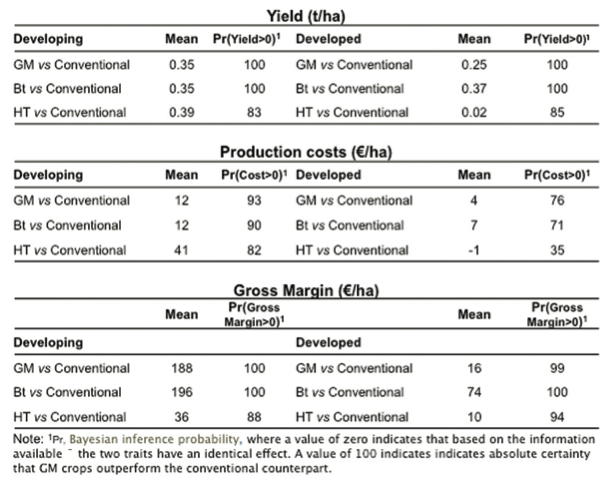
Table 1. Mean of absolute difference of the yield, production costs and gross margins between GM and conventional crops for develop- ing and developed countries.
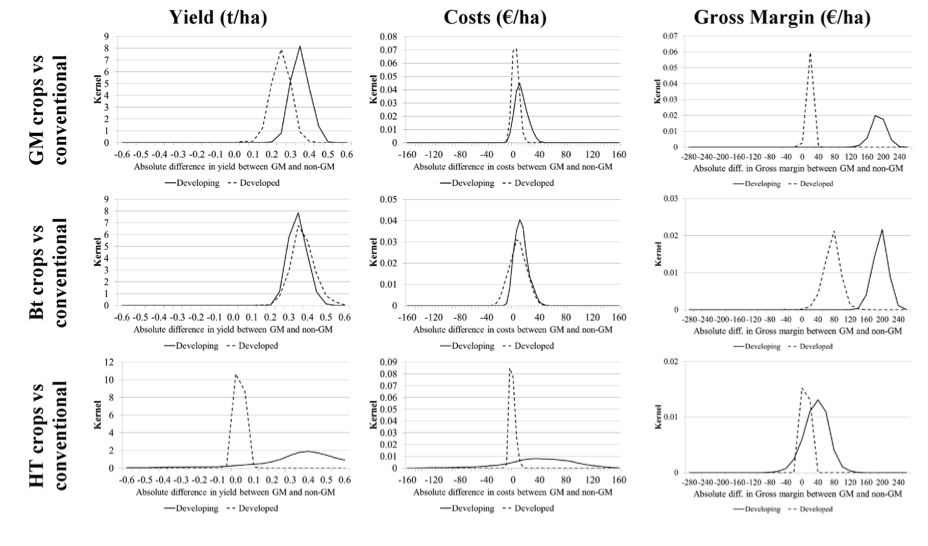
Figure 1. Comparisons of the distribution of absolute values for the difference between GM and conven- tional crops in yield, production costs and gross margin for developed and developing countries. The verti- cal axis is the value of the kernel smoothing function to show the distribution of the differences; values on the horizontal axes are expressed as: tonnes/ha, or as €/ha. Curves are based on results from 63 published sets of data where the difference parameter was calculated as: (GM minus non GM).
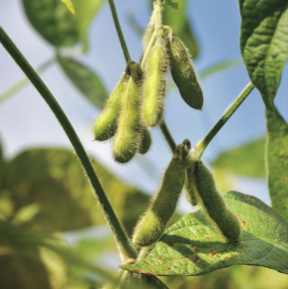
HT soybeans
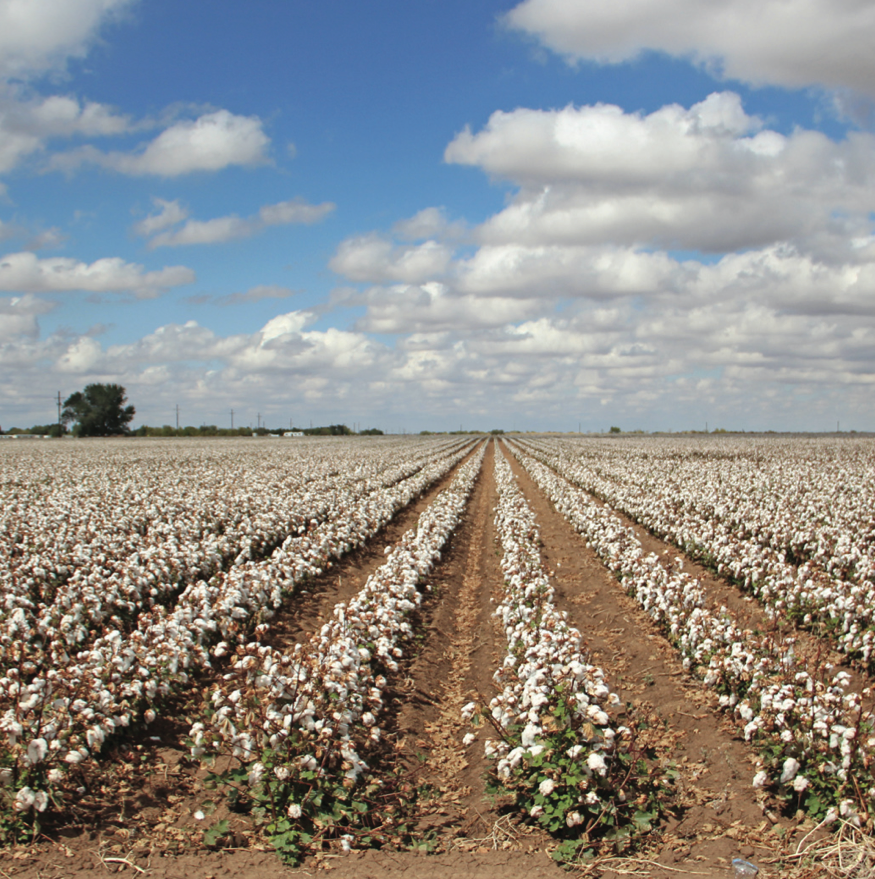
Bt cotton crop in Texas.

